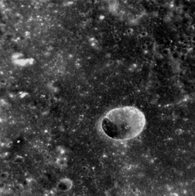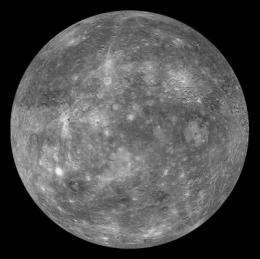Mercury's surprising core and landscape curiosities

(PhysOrg.com) -- On March 17, the tiny MESSENGER spacecraft completed its primary mission to orbit and observe the planet Mercury for one Earth-year. The bounty of surprises from the mission has completely altered our understanding of the solar system's innermost planet. As reported in one of two papers published today on Science Express, scientists have found that Mercury's core, already suspected to occupy a greater fraction of the planet's interior than do the cores of Earth, Venus, or Mars, is even larger than anticipated. The companion paper shows that the elevation ranges on Mercury are much smaller than on Mars or the Moon and documents evidence that there have been large-scale changes to Mercury's topography since the earliest phases of the planet's geological history.
The mission's many successes have allowed it to be extended for another year. "The first year of MESSENGER orbital observations has yielded a wonderful harvest of results," says MESSENGER Principal Investigator Sean Solomon, of the Carnegie Institution and a coauthor of the two papers. "From Mercury's extraordinarily dynamic magnetosphere and exosphere to the unexpectedly volatile-rich composition of its surface and interior, our inner planetary neighbor is now seen to be very different from what we imagined just a few years ago. The number and diversity of new findings being presented this week to the scientific community in these papers and in presentations at this week's Lunar and Planetary Science Conference provide a striking measure of how much we have learned to date."

A Surprising Core
MESSENGER's radio tracking has allowed the scientific team to develop the first precise model of Mercury's gravity field which, when combined with topographic data and the planet's spin state, sheds light on the planet's internal structure, the thickness of its crust, the size and state of its core, and its tectonic and thermal history.
Mercury's core occupies a large fraction of the planet, about 85% of the planetary radius, even larger than previous estimates. Because of the planet's small size, at one time many scientists thought the interior should have cooled to the point that the core would be solid. However, subtle dynamical motions measured from Earth-based radar, combined with MESSENGER's newly measured parameters of the gravity field and the characteristics of Mercury's internal magnetic field that signify an active core dynamo, indicate that the planet's core is at least partially liquid.
Mercury's core is different from any other planetary core in the Solar System. Earth has a metallic, liquid outer core sitting above a solid inner core. Mercury appears to have a solid silicate crust and mantle overlying a solid, iron sulfide outer core layer, a deeper liquid core layer, and possibly a solid inner core. These results have implications for how Mercury's magnetic field is generated and for understanding how the planet evolved thermally.
Landscape Curiosities
A planet's topography can reveal fundamental information about its internal structure and its geological and thermal evolution. Ranging observations from MESSENGER's Mercury Laser Altimeter (MLA) have provided the first-ever precise topographic model of the planet's northern hemisphere and characterized slopes and surface roughness over a range of spatial scales. From MESSENGER's eccentric, near-polar orbit, the MLA illuminates surface areas as wide as 15 to 100 meters (50 -325 feet), spaced about 400 meters apart (1,300 feet).
The spread in elevations is considerably smaller than those of Mars or the Moon. The most prominent feature is an extensive area of lowlands at high northern latitudes that hosts the volcanic northern plains. Within this lowland region is a broad topographic rise that formed after the volcanic plains were emplaced.
At mid-latitudes, the interior plains of the Caloris impact basin — 1,550 kilometers (960 miles) in diameter — have been modified so that part of the basin floor now stands higher than the rim. The elevated portion appears to be part of a quasi-linear rise that extends for approximately half the planetary circumference at mid-latitudes. These features imply that large-scale changes to Mercury's topography occurred after the era of impact basin formation and large-scale emplacement of volcanic plains had ended.
These and other latest findings from MESSENGER will be featured in 57 papers presented this week at the 43rd Lunar and Planetary Science Conference in The Woodlands, Texas.
Provided by Carnegie Institution



















